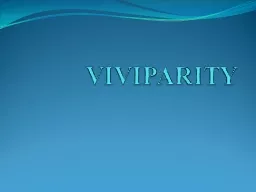PPT-V IVIPARITY Viviparity
Author : PrincessPeach | Published Date : 2022-08-04
Some insects produce living young ones instead of laying eggs or in other words give birth to the larvae and the process is called viviparity Though it is not
Presentation Embed Code
Download Presentation
Download Presentation The PPT/PDF document "V IVIPARITY Viviparity" is the property of its rightful owner. Permission is granted to download and print the materials on this website for personal, non-commercial use only, and to display it on your personal computer provided you do not modify the materials and that you retain all copyright notices contained in the materials. By downloading content from our website, you accept the terms of this agreement.
V IVIPARITY Viviparity: Transcript
Some insects produce living young ones instead of laying eggs or in other words give birth to the larvae and the process is called viviparity Though it is not a true viviparity as occur in mammals because it lacks a typical .
Download Rules Of Document
"V IVIPARITY Viviparity"The content belongs to its owner. You may download and print it for personal use, without modification, and keep all copyright notices. By downloading, you agree to these terms.
Related Documents

